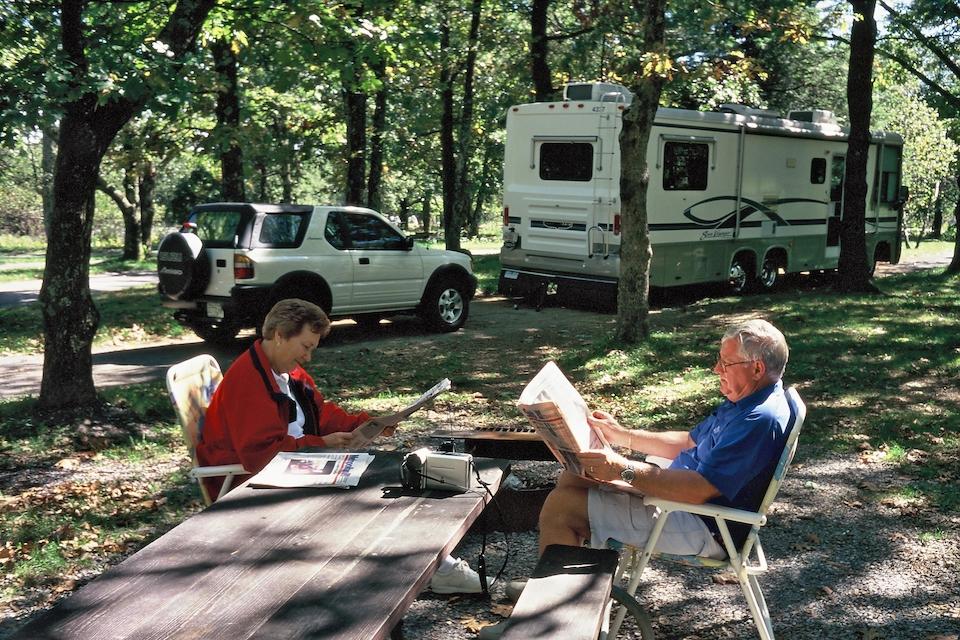
National park campgrounds, such as this one at Big Meadows in Shenandoah National Park, are the best basecamps for RV exploration of the parks/NPS
During our 20s and early 30s, we carried a pack into the woods. But after one taste of the RV life, we were hooked. Sleeping on the ground became a thing of the past once my husband and I discovered the joys of camping in spectacular settings with the option to enjoy water, electric, and sewer utilities. If you’ve ever considered doing the same, here’s what you need to know about plugging into America’s national parks with RV hookup campsites.
When Camping with RV Hookups Make Sense
We traded our backpacks for a fifth-wheel trailer in 2008, but rarely visited RV parks with hookups. “That’s not real camping!” we joked as we opted for rustic dry camping in public campgrounds. Twelve years later, we are more open to occasionally enjoying those full-hookup creature comforts. Maybe we’ve gone soft, but now we understand that connecting to RV hookups in national parks makes total sense sometimes. For example:
Why Have Full Hookups in National Parks?
- In hot weather, you can run the air conditioner. This greatly reduces the heatstroke risk for pets, infants, and the elderly.
- When cold weather strikes, you can set and forget the heater thermostat. A comfortable indoor temperature allows RVers like us to visit national parks during the off-season and reduce park overcrowding.
- Electric medical devices like C-PAP machines need a reliable power source. Electrical hookups allow medically-compromised campers to enjoy America's treasures, without emitting noisy generator power.
As a bonus, sewer connections can reduce RVers’ carbon footprints because we can stay put in one place for longer periods of time. And finally, RV hookups eliminate noisy generator exhaust from the campground.
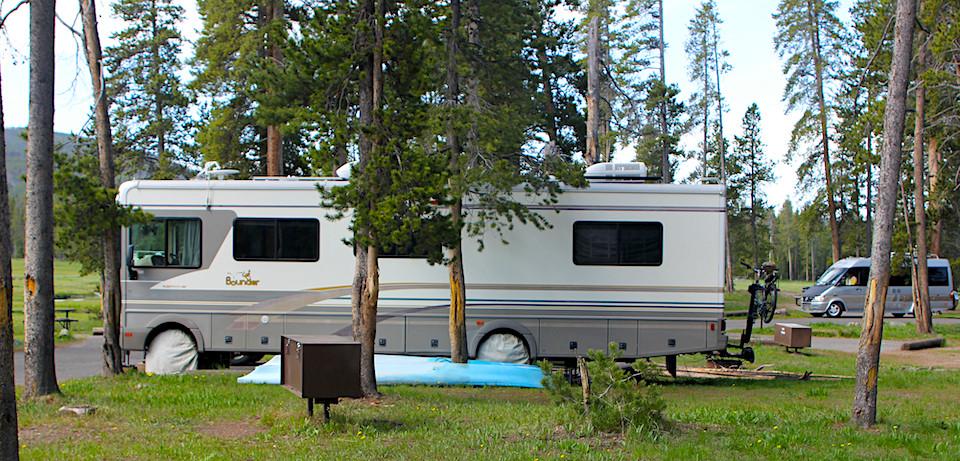
"Dry" campgrounds in the national parks are easier to land sites at than full-hookup sites/Norris Campground, Yellowstone National Park, NPS/Diane Renkin
Where to Find National Parks with RV Hookup Campsites
Privately-owned, full-hookup RV parks and campgrounds are easily found outside national parks. So why should RVers look for spots inside the park? Because it’s the best way to enjoy an immersive national park camping experience. You’ll drive less and spend more time enjoying the natural features that drew you there in the first place.
The National Park System has 130 destinations with overnight camping. Getting a dry campsite (no hookups) in one of them is relatively easy. Unfortunately, only 13 parks have full or partial utility connections for RVs. If you’re lucky enough to reserve one of these luxury campsites, you will probably discover a more genuine, back-to-nature experience than the privately-owned RV parks located beyond park gates.
To find these campsite gems, take a look at the “Where Can I Camp” directory of camping locations in the National Park Service. You will see just five national park sites with full-hookup RV camping. Seven more provide water or electric or water and electric hookups. It all adds up to stiff competition for utilities in the following locations:
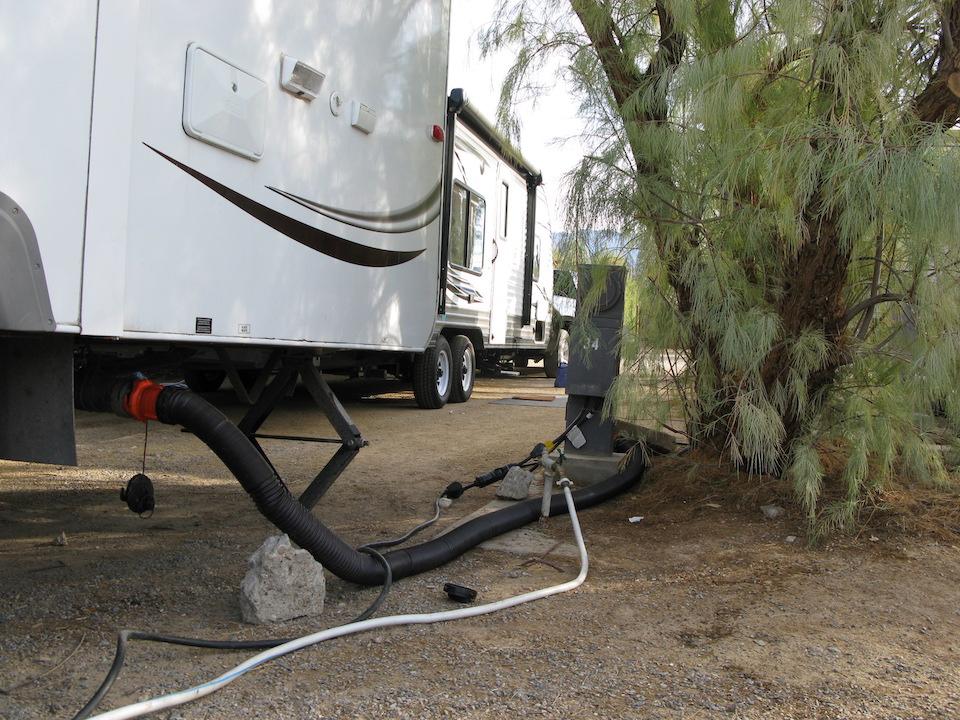
Full hookup campgrounds, such as Furnace Creek in Death Valley National Park, allow you to be self-contained and comfortable/Rene Agredano
U.S. National Parks with Full Hookups for RVs (water, sewer and electric)
Arizona | Grand Canyon National Park: Trailer Village
- 29 full-hookup sites for RV’s up to 28 feet long.
- 50 full-hookup sites for RVs up to 50 feet long.
California | Death Valley National Park
- Furnace Creek: 18 full-hookup sites. Max RV size: 36’
- Stovepipe Wells: 14 full-hookup sites: Maximum RV size: 60’
- Panamint Springs: 6 full-hookup sites: Maximum RV size: 60’
Texas | Big Bend National Park: Rio Grande Village RV Park
- 20 full-hookup sites for reservations only
- 5 full-hookup sites for walk-ups
- Max RV Size: 40-50' depending on occupancy load.
Wyoming | Yellowstone National Park: Fishing Bridge RV Park
- 346 full-hookup campsites for hard-sided RVs only. Max RV Size: 40'
Wyoming | Grand Teton National Park: Colter Bay RV Park
- 142 full-hookup sites. Max RV Size: unlimited for pull-through, 30' for back-in spots.
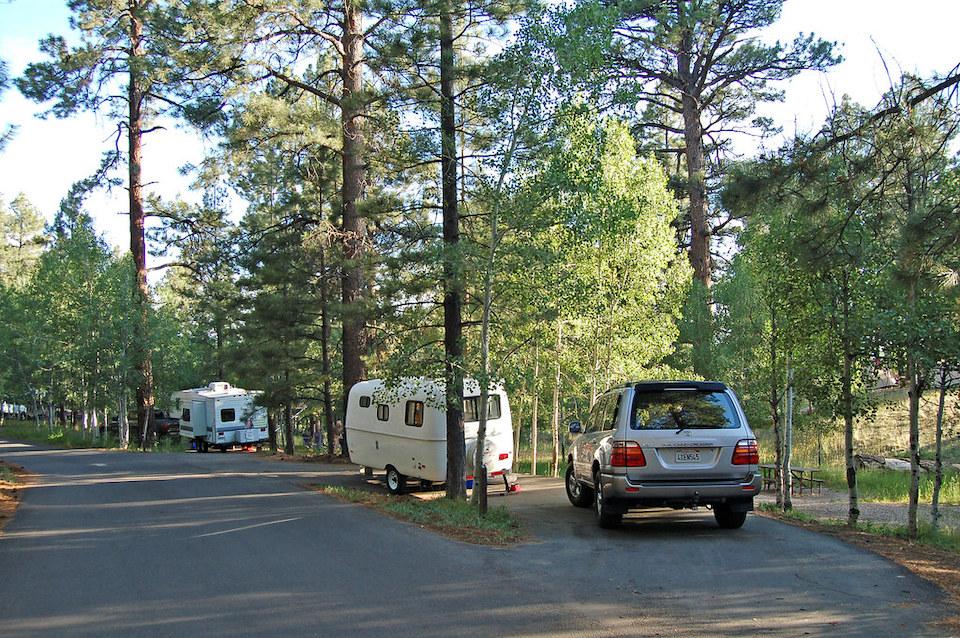
North Rim Campground at Grand Canyon National Park lacks full hookups, but has a dump station/NPS
U.S. National Parks with Basic Hookups for RVs (water, electric, or both)
Colorado | Black Canyon of the Gunnison National Park: South Rim Campground (electric only)
- 23 electric hookup campsites. Max RV Size: 40’
Florida/Mississippi | Gulf Islands National Seashore:
- Davis Bayou Campground (MS): 52 electric hookup campsites. Max RV Size: 40’
- Fort Pickens Campground (FL): 137 electric hookup campsites. Max RV Size: 40’
South Dakota | Badlands National Park: Cedar Pass (electric only)
- 20 electric hookup campsites. Max RV Size: 70’
Tennessee/Kentucky | Big South Fork National River and Recreation Area
- Blue Heron Campground (KY): 45 electric hookup campsites. Max RV Size: 45’
- Bandy Creek Campground (TN): 96 electric hookup campsites. Max RV Size: 51’
Florida Everglades | Flamingo Campground (electric only)
- 41 electric hookup campsites. Max RV Size: 44’
Things to Know About National Park RV Campsites with Hookups
Advance reservations are a must.
The secret is out: National park RV campsites with hookups are a good deal when compared to nearby rivately owned RV campgrounds. A 2018 National Park Campground Usage Study revealed that many national park campgrounds are near or at capacity for most of the year. Each year thousands of RVers like you and I compete for these precious few sites, so don’t plan on freewheeling without a reservation. When wanderlust strikes, give yourself at least a six-month window ahead of your desired arrival date at the park. Create a flexible plan with alternate camping dates and remember to take advantage of slower times by visiting on a weekday.
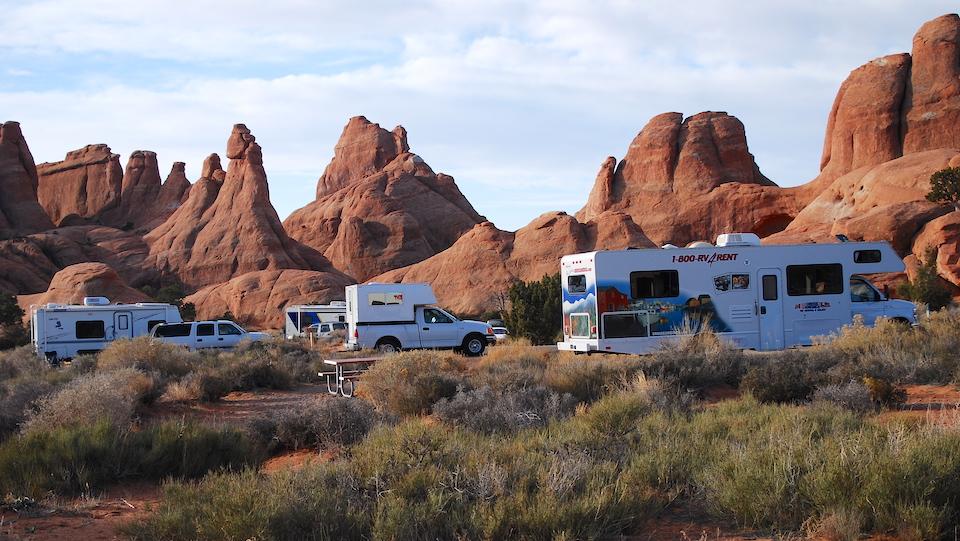
Devils Garden Campground at Arches National Park can be particularly challenging to land a spot in if you don't start far in advance/Kurt Repanshek file
The reservations process differs from park to park.
The method to reserve national park campsites is inconsistent across sites. Some vendors only reserve campsites by telephone, but most allow you to do the entire transaction online. Only a few national parks settings, like Furnace Creek at Death Valley National Park, are booked through Recreation.gov, the Internet clearinghouse for public lands recreation reservations. Otherwise, the website for your intended park destination will direct you to the right booking portal. However you reserve a stay, it’s up to you to learn the campground rules for making, changing and canceling reservations.
Know your measurements.
If your RV is on the small side, you’re in luck. Most national park campgrounds cannot accommodate larger, modern RVs over 40 feet long. Therefore, when reviewing RV campsite possibilities, pay close attention to the maximum RV size allowed. This number factors in total RV length, including a tow or towed vehicle.
You also want to consider the width and length of the parking apron. All wheels must be on the parking spot. If yours don’t fit, you will be asked to move or leave. If you don’t know the total length and size of your RV setup, head to a professional RV weigh scale with experts who can figure it out for you.
Carry the right RV supplies.
Utility hookups in national parks are usually reliable, but it doesn’t hurt to prepare for the worst. The most important RV supplies you can have onboard wherever you roam include:
- An exterior RV water filter hose attachment, to reduce the chance of heavy minerals or other contaminants getting into your water lines.
- Formaldehyde-free RV toilet chemicals, to ensure the integrity of a park’s delicate septic system.
- A surge protector for your RV power supply, to lessen the risk of plugging into outdated utility pedestal connections that can damage your electrical system.
If you’re new to RVing, you might be thinking that all the pre-planning is a lot of work. You’re correct, it is. But take it from someone who has camped in national parks from coast-to-coast: scoring a full-hookup RV campsite in beautiful parks like Big Bend or Yellowstone can make you feel as if you won the lottery. And although carrying a backpack into the wilderness, or car camping with a tent requires fewer logistics than the RV life, for campers like me who enjoy a comfortable night’s sleep on a good mattress, the privilege of setting up a temporary home in a world-famous outdoor destination always makes up for the extra steps required to get there.



Comments
If you have to tote your house with you when you travel then perhaps the "national park experience" (whatever that is) is not for you, and you should be staying outside the parks. As I recall, vehicles with trailers or longer than 21 ft are not allowed on the Going to the Sun Road in Glacier. I think that would be a good policy in all our national parks, both in the camp grounds and on the roads (some of these BIG rigs take up 3, 4 parking spots.). Small RV's, vans, campers, sure, but not these monstrosities the size of a Grayhound bus. As for me, I camp/sleep in my Honda Element (roof top tents are now a real option, too) for 2 to 5 nights and then get a motel room for a night.
i am on dialysis and having an electric hookup allows me to go camping. I require electricity for my dialysis machine.
It's interesting that despite the reasons listed in the article (and the tons that weren't) that there are some people who have commented who just don't want campers - or very much of a camper - in the NPS. I've noticed this sentiment shared on other websites I've looked at recently too. My parents camped in tents when they were kids. We were in pop-ups when I was a kid. These days when the family group camps we're all in hard-sided campers. It makes a difference when you're grandmother is 94 to have a place to go when the rains and wind come. Or the heat. Or the bitter cold. Many of them will camp 2 weeks at a time at the COE campground nearby because they love sitting outside and being in nature. I don't mind taking a good ribbing from my friends that my family is "glamping". It's done in good humor and quite honestly it's the only way I can get my wife to come along when I try to expose the kids to the fun I had as a kid. There are ways to have primitive, water/electrical tent spots, and water/electrical/full hookup spots for RVs in the same park and still preserve the tent camping experience for those that want it, while at the same time allowing those that need/want a camper to experience the park too (I couldn't care less about cable/WiFi, etc. because the kids leave the electronics behind and we're outside unless the weather turns). We know families with 8 kids because they adopt. So we shouldn't allow their 35 foot RV in to experience the park? Are their tax dollars not good enough? Only those with 2-4 people that can fit into a tent or pop-up perhaps then? I'm all for preserving the natural experience of the parks. But tent camping in a park doesn't make you a good steward of the land anymore than owning an RV doesn't make me a good steward. It doesn't even get you that much closer to nature when we both could look at each other from our lawn chairs or go hiking down the same trails. Bringing the existing RV spots up to current specs for RVs, clearing out low-hanging branches, and adding some spots won't be the end of the NPS. I guess the point of this long comment is to ask that those opposed to the idea to try to stop thinking of RVs as invading the NPS (my term), and to start thinking more along the lines of welcoming your neighbors. That's what I think of when I think of my camping trips as a kid. That's what I want my kids to get out of it.
An item of equipment that every RV camper should have would be leveling blocks. I volunteer at a state park in Texas. Our RV sites are fairly level but not perfect. You would be surprised at how many people show up without any way to level their rig and then complain that the sites aren't perfect.
Hasn't it changed now, where everyone has to wait in line for a site at the ranger check-in station for each campground?
2 comments - I'm sitting in my RV in Zion National Park plugged into their electric, so this is another park with partial hook ups.
Secondly, most, if not all, of the full hook up sites are run by concessioners. This means that Access Passes, or other passea that give 50% off camping, may or may not be accepted. It also means you may have extra person fees and taxes on top of the camping rate. This is certainly true at Big Bend.
So those of us who require hookup RV sites for medical or health issues, disabled combat veterans etc are not worthy of staying within a National park? I never realized that OUR national parks were so selective on who is allowed to stay within the park. Hmm last time I checked our Country Laws, we disabled citizens have the same rights of access. Especially families that served our country and defended our rights and freedom
Agree. The quietest neighbors I've had in National Parks have been the big rigs. The noisiest and most intrusive have been tenters. You might even stretch the generalizations to say that those with the big rigs possibly pay more taxes to support the parks than those in tents. They usually pay more for the site at the very least. We dont have a big rig but we do have a smaller motorhome. For health reasons we would not be able to go at all if we had to do the rustic version of camping (which we did when we were younger). We support National Parks with donations as well, not just during use. The national parks are for everyone, not just those who want to sleep in soft sided 'homes' or under the stars.